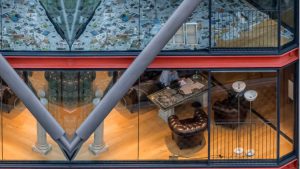MOLECULAR: ASBESTUS AND FIRE
Curator: Uras Kızıl
Art Talk: Ozan Atalan & Uras Kızıl
03.07.2024
Bilsart presents Ozan Atalan’s exhibition entitled “Molecular: Asbestus and Fire” between 3 July – 13 July 2024 curated by Uras Kızıl.
The exhibition “Molecular: Asbestos and Fire” (2024) centers around asbestos, a material found in nature in long fibers within rocks, focusing on the hidden relationships surrounding asbestos. Ozan Atalan traces the extensive industrial use of asbestos by recognizing its potential forces. In this tracing process, Atalan calls upon the brick wall, one of the iterative images of his art, for version-specific political image production.
The presence of the brick wall evokes an involuntary need in the viewer to look and examine it closely. This makes the wall both participatory and inviting. This act of looking goes beyond a superficial glance, aligning with a seeing-in action that penetrates inward. Such an act of seeing cannot be explained through representation alone but emerges through sensory codes. It requires speculative narratives that open up to secondary meanings or interpretations, detached from the object’s visible reality.
So, how are these speculative narratives constructed with the brick wall in the context of the exhibition?
The wall’s sharing of its space to make room for a window serves various speculative readings in this specific exhibition. The condition of looking out from the window, traditionally used by the artist to reflect the reality of the outside world, does not apply here. The presence of the window deconstructs the historical acts of seeing and making in art. Although the relationship established between the window and the screen initially directs the viewer to look into the void and then at the screen, the void is not the sole condition for seeing. The deliberate deactivation of the window implies that the act of seeing can be achieved through the viewer’s possible positions within the space.
Another parameter in the choice of the brick wall is its relationship with asbestos as a hyperobject(1). Asbestos can be thought of as an invisible hyperobject that becomes apparent through the participation of another actor (typically a third actor). The point at which asbestos, as a hyperobject, makes its presence felt is realized through the movement of another hyperobject: fault lines. Asbestos emerges from among destructions. Atalan makes asbestos visible by using the possibilities of the brick wall, which we have been exposed to for several years, and integrating ChatGPT into the process. Atalan directs his questions about asbestos to ChatGPT. The ‘Socratic dialogue’ he engages in with ChatGPT and the resulting answers form early documentation of ChatGPT. The effort to test AI with questions inherent to new materialism and its deconstruction pertains to the patterns of this documentation. The answers provided by AI indicate evasiveness, circling around the issues and adopting a politically correct stance.
The images seen on the screen behind the brick wall form video collages that follow one another in sequence. These images, produced in collaboration with AI, create a speculative visual repertoire of asbestos, which is impossible to access directly. There is a second element added to the speculative asbestos images: video recordings of the Library of Ephesus and the four female statues at its entrance(2). Atalan opens the production of knowledge systems in contemporary technology to an intra-artifact(3) reading with ‘prehistoric’ knowledge production. He achieves this by positioning himself as the subject of the research.
“Molecular: Asbestos and Fire” emphasizes the importance of dispelling the malign political attitude attributed to asbestos and distributing responsibility equally. The process necessitates an indirect approach to research due to the impossibility of physically recording asbestos. Hence, it calls upon qualitative post-research methods in an applied manner. The events themselves transform into a structure, making asbestos visible. The focus is on the process rather than the result. The entire process is made possible by documenting an ongoing performative act.
[1] Hipernesne is a term borrowed from Timothy Morton’s concept of Hyperobjects.
[2] The four female statues in the Library of Ephesus include Sophia (Wisdom), Episteme (Knowledge), Ennoia (Intelligence), and Arete (Virtue).
[3] Intra-art(i)fact is conceptualized in Uras Kızıl’s doctoral thesis titled “Reflections of the New Materialist Understanding of Matter and its (Anti)Relation to Romanticism in Contemporary Art: An Intra-Artistic New Materialist Analysis.”
ABOUT OZAN ATALAN
Ozan Atalan (b. 1985, Gallipoli) is a visual artist and lecturer at Florida International University. He holds bachelor’s degrees from Anadolu University Faculty of Law (2007) and Dokuz Eylul University Faculty of Fine Arts, Department of Sculpture (2013). He earned his Master of Fine Arts from Syracuse University as a Fulbright scholar (2016) and his Doctorate in Art from Yaşar University (2024). He has taught sculpture courses at Syracuse University (2015-2016) and art and design courses at Yaşar University (2024) and İzmir University of Economics, Department of Visual Communication Design (2016-2023). His transmedia, interdisciplinary, and research-based works, primarily focusing on video installations, explore the intersection of social sciences such as psychology, anthropology, and philosophy with natural sciences like biology, quantum physics, and ecology. Atalan focuses on the co-evolution of human and non-human forms, reflecting eco-queer performativity from a critical posthumanist perspective. His works have been exhibited in prominent national and international venues such as the 16th Istanbul Biennial, Istanbul Museum of Modern Art, Montpellier Contemporain, Pera Museum, and Migros Museum of Contemporary Art.








